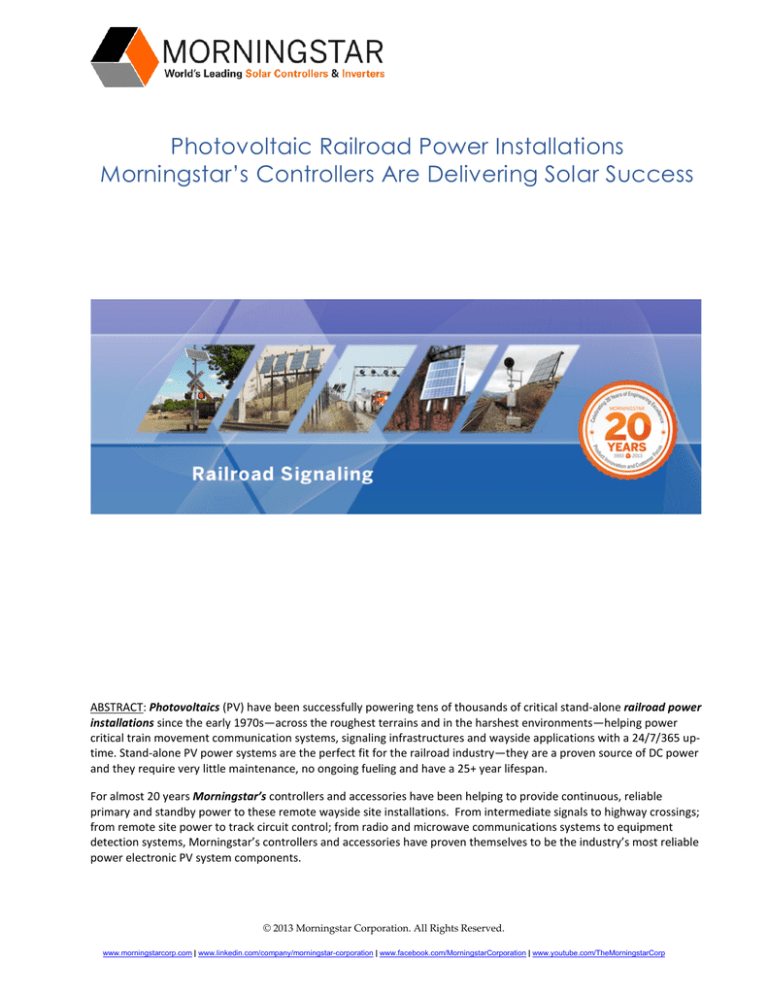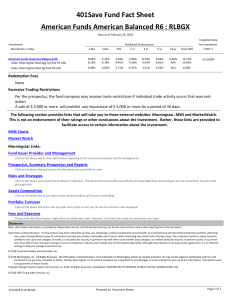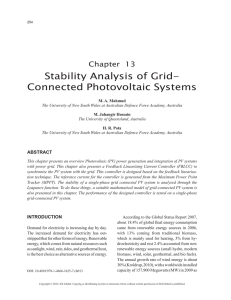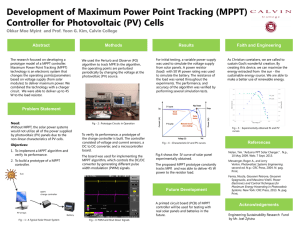
Photovoltaic Railroad Power Installations
Morningstar’s Controllers Are Delivering Solar Success
ABSTRACT: Photovoltaics (PV) have been successfully powering tens of thousands of critical stand-alone railroad power
installations since the early 1970s—across the roughest terrains and in the harshest environments—helping power
critical train movement communication systems, signaling infrastructures and wayside applications with a 24/7/365 uptime. Stand-alone PV power systems are the perfect fit for the railroad industry—they are a proven source of DC power
and they require very little maintenance, no ongoing fueling and have a 25+ year lifespan.
For almost 20 years Morningstar’s controllers and accessories have been helping to provide continuous, reliable
primary and standby power to these remote wayside site installations. From intermediate signals to highway crossings;
from remote site power to track circuit control; from radio and microwave communications systems to equipment
detection systems, Morningstar’s controllers and accessories have proven themselves to be the industry’s most reliable
power electronic PV system components.
© 2013 Morningstar Corporation. All Rights Reserved.
www.morningstarcorp.com | www.linkedin.com/company/morningstar-corporation | www.facebook.com/MorningstarCorporation | www.youtube.com/TheMorningstarCorp
Photovoltaic Railroad Power Installations
… Morningstar’s Controllers Are Delivering Solar Success
Introduction
The rail industry has been a pioneer of the digital age and a leader in many technological advances,
such as sensors that can detect when wheels and tracks are about to give out from stress. Railroads
were an early adopter of technologies like RFID (radio frequency identification), which uses tags and
radio waves to track the flow of trains and cargo. Today, the industry is embracing wireless sensors
to provide better information on train movements, to improve efficiency and safety as well as to
enable PTC (positive train control) in “dark territories”. Additionally, since many run through parks
and residential areas, they are also increasingly more interested in reducing greenhouse emissions.1
At the forefront of technology innovation, the railroad
industry was one of the first to adopt PV power. A railroad
operates with a simple focus—profitability + safety. Trains
must run on time and critical wayside applications must
work—safety is paramount. Inoperable gates, signals and
communication systems simply are not an option. The
industry demands a PV power system that provides high
output, is reliable, has high system autonomy and is
operationally cost-effective. Additionally, more and more
railroads are beginning to ask for wayside PV power
systems that support standards-based remote monitoring
capabilities. They want these systems to provide system
health and performance data.
The railroads adopted PV for one simple reason—the grid
and rail line locations are not in sync. The grid is neither a
convenient nor a cost-effective solution for a railroad. More
times than not, the grid it is distributed far from where a
railroad needs power; and where it the grid may be present,
a right-of-way negotiation may be required and could be
costly. These logistical and operational challenges are
something the railroads decided to forgo 40+ years ago. In
the old days, the railroad ran “signaling pole lines” for their
power and communication systems, but that proved
extremely expensive and, at times, unreliable. The polelines were constructed using copper lines, which were
expensive and also prone to storm damage and theft. Over
time, they evolved their power infrastructure to the more
reliable coded-signaling systems, which used pulse line
technology. This evolution brought with it a need for remote
power at every 1-2 mile internal. This new technology and
power requirement made PV the ideal solution.
ALL.DAT.RR.PRIMER.09/13.EN | Page 1 of 7
Photovoltaic Railroad Power Installations
… Morningstar’s Controllers Are Delivering Solar Success
Today, the railroad is the most cost-effective and energyefficient way to move freight. Railroads are also greener and
more sustainable than ever—delivering environmental and
safety benefits.4
•
•
Switching from truck to rail shipments means less fuel
used and less greenhouse gas released.
Every mile that a truck, or car for that matter, is not
driven adds to the safety of everyone else on the road.
Furthermore, in recent years the railroad industry has adopted
the use of LED Signal Lights, which along with the use of the
digital, pulse technology, has greatly lowered power
consumption and helped fuel the use of Solar by the railroad
industry.
Case in Point - North America
North America’s railroads move more goods across the continent than any other transport
medium. Additionally, with fuel prices rising and shipping rates better than they have been
in over a decade, railroad’s freight industry is experiencing a resurgence2. A train can move
one ton 450-500 miles on one gallon of fuel—a train can carry the load of 280 trucks4—
which makes it three to four times more fuel-efficient than trucks. In fact, in 2012 the U.S.
freight railroads spent $10.7B on new trains, tracks and other infrastructure, their highest
amount ever. As a frame of reference, according to the Federal Railroad Association’s
National Rail Plan3:
•
America’s freight rail network spans 140,000 miles.
•
The rail industry is reinvesting 40 cents of every dollar they earn back into
infrastructure.
•
The total freight shipments are expected to rise 61% in the next three decades to
16.9B tons in 2050. That’s quite a leap from 2010 figures, when roughly 12.5B tons
were moved.
ALL.DAT.RR.PRIMER.09/13.EN | Page 2 of 7
Photovoltaic Railroad Power Installations
… Morningstar’s Controllers Are Delivering Solar Success
Morningstar – The Controller of Choice for Railroading
Since 1995, Morningstar’s controllers have been helping regulate
railroad’s off-grid PV power systems. Whether the wayside
systems are PV-only or Hybrid (PV + secondary energy source)
power installations, our controllers and accessories have been
helping the railroad industry move trains reliably, safely and on
schedule.
Morningstar’s first and second generation ProStar™ controllers
were the first to be embraced by railroad’s wayside PV power
systems and to this day operate reliably in several thousand
system installations worldwide. Additionally, Morningstar’s
Relay Driver has become the accessory of choice for railroad’s
low-voltage alarm applications and hybrid power installations.
In 2008, we introduced our innovative
TrakStar™ Maximum Power Point
Tracking (MPPT) algorithm technology
that maximizes the energy harvest from the PV array into the
battery under all operating conditions. This technology
innovation is used in Morningstar’s SunSaver MPPT™ and TriStar
MPPT™ controllers and has resulted in the TriStar MPPT
controller becoming the world-leading MPPT solar controller. Morningstar’s TrakStar MPPT
algorithm provides more accurate and faster tracking, consistently operating at the PV array’s real
maximum power point. Leveraging TrakStar, Morningstar’s MPPT controllers deliver high
conversion efficiency at all power levels resulting in:
* Significantly better in conversion efficiency at lower output levels.
* Substantially better production at higher output levels.
Since their introduction in 2009, Morningstar’s TriStar MPPT controllers became the controller of
choice for railroad’s wayside PV power system installations. Per the industry’s requirement for
highly reliable, efficient power systems, the TriStar MPPT controller allows the solar array to be
configured at voltages higher than the system battery. This enables a more effective use of all the
solar energy reaching the modules, while also reducing voltage and power losses in the connections
between the arrays and the controller.
ALL.DAT.RR.PRIMER.09/13.EN | Page 3 of 7
Photovoltaic Railroad Power Installations
… Morningstar’s Controllers Are Delivering Solar Success
The TriStar MPPT Controller has helped make pole line maintenance safer. As pictured in the triple
tower PV system installation below, the solar modules are now mounted using a retractable tower
system. As such, the maintenance crew no longer has to risk a high climb –they can simply service
the modules at ground level. To facilitate
this safety innovation, these new
retractable towers can no longer use the
large and bulky copper wire bundles of
‘yester-year’. Instead, they require small
gauge wire loops, which expand and
contract as the PV array is raised and
lowered. Morningstar’s TriStar MPPT
Controllers help to efficiently enable these
systems’ to work without voltage losses,
using a more cost-effective lower gauge
wiring solution.
Traditionally, the railroad has built its track
following river bed bottoms, as
geographically that creates a track path
that is easier follow and more cost-effective to install. But these installations can traverse many
cliffs and bluffs and thusly require the PV array to not always be co-located with the wayside power
system’s battery bank. Morningstar’s TriStar MPPT Controllers are also perfectly suited for this
installation scenario. Using our innovative TrakStar MPPT technology, the TriStar MPPT Controller
makes greater distance (long wire
run) installations possible—no
longer does the solar array need to
be located near the battery storage
(system bungalows). In fact, in
Montana, our controllers are helping
to regulate a PV system, where the
array is installed 600ft from the
wayside installation’s battery
system.
ALL.DAT.RR.PRIMER.09/13.EN | Page 4 of 7
Photovoltaic Railroad Power Installations
… Morningstar’s Controllers Are Delivering Solar Success
The TriStar MPPT controller is also the PV
industry’s only controller to use industrystandard communication protocols and
interfaces—a perfect fit for railroad’s new
requirement to have their PV systems
support standards-based remote monitoring
capabilities. The TriStar MPPT controller
enables system monitoring and up to 200
days of data logging and uses the open
MODBUS™ protocol. It is also equipped
with an on-board RS-232 serial
communications port. Furthermore, the 60
Amp TriStar MPPT controller (model TSMPPT-60A) is EIA-485 and Ethernetequipped to enable open and flexible serial
communications and TCP/IP networking,
respectively.
The TriStar MPPT controller is manufactured in an ISO 9001 certified facility and meets several key
certification standards, including:
•
•
•
•
•
•
AREMA Compliant
EMC Compliant (Immunity, Emissions and Safety)
UL 1741 and CSA C22.2 No. 107.1-01 Listed
FCC Class B Part 15 Compliant
NEC Compliant
CE, REACH and RoHS Certified
Sample Typical Power System Scenarios
•
Railroad wayside power installations typically need to run fairly heavy loads using a 12V battery
system. E.g., a Defect Equipment Detection system could use 5 PV modules in Series to charge a 12V
battery. This application is easily enabled by Morningstar’s TS-MPPT-60A controller.
•
Furthermore, if that system is located in a valley, where the PV array is only exposed to sun light for
a limited time (e.g., fewer than three hours per day) then the TS-MPPT-60A is the best choice. The
higher input voltage capacity of the TS-MPPT-60A enables the system installer to “wire up” the
power system to almost 100V input and to mount the PV array far up a hill—away from the valley
location –to a higher solar irradiance location. The TS-MPPT-60A offers the industry’s best
conversion efficiency (99%), which is especially useful in this lower output level scenario.
ALL.DAT.RR.PRIMER.09/13.EN | Page 5 of 7
Photovoltaic Railroad Power Installations
… Morningstar’s Controllers Are Delivering Solar Success
Summary
For more than 20 years, Morningstar’s products have
been helping provide stand-alone, solar electric power
to many industrial system installations around the
world—telecommunications, oil and gas, security and
instrumentation. Further, since 1995, Morningstar’s
products have been helping regulate railroad’s off-grid
PV power systems. Whether the wayside systems are
PV-only or Hybrid (PV + secondary energy source)
power installations, our controllers and accessories
are helping the railroad industry move trains reliably,
safely and on schedule.
Better Efficiency across a Broad
Operating Range
Better Efficiency at Lower Power Levels
Morningstar’s TriStar MPPT Controllers
have significantly better efficiency at
lower power levels. Unlike other
products, which must operate at close to
their nominal power rating to reach their
peak operating efficiency, the TriStar
reaches its ideal operating efficiency at as
little as 20% of rated power and
Morningstar’s products are renowned for their robust
thermal, mechanical and electronic circuitry design,
high quality and outstanding reliability, and long
operating life and dependable performance. Our
products are integral power electronic components in
more than two million off-grid photovoltaic power
systems in 112 countries, across all seven continents.
They get the job done when utility power is
unavailable, unreliable or cost-prohibitive.
To learn more: www.morningstarcorp.com
maintains this level throughout most of
its operating range.
Significantly Better Efficiency at Higher
Power Levels
Morningstar’s TriStar MPPT Controllers
have significantly better efficiency at
higher output levels. Other brands peak
at 1/3 of the maximum current and taper
off at higher currents, but the TriStar
MPPT will provide extra power when it
is needed most.
ALL.DAT.RR.PRIMER.09/13.EN | Page 6 of 7
Photovoltaic Railroad Power Installations
… Morningstar’s Controllers Are Delivering Solar Success
Higher State of Charge
•
Morningstar’s TriStar MPPT controllers keep the batteries at a higher State of Charge (SoC), given the
same PV array compared to an identical system using a competitor's controller. A higher average SoC
means better battery health and longer battery bank life. It also means better and longer system
autonomy.
Highest Efficiency and Reliability
•
Morningstar’s TriStar MPPT controllers deliver better production at higher ambient temperatures for all
operating conditions. Delivering the industry’s highest reliability and operating life, the TriStar MPPT
controllers feature a robust thermal and mechanical design. Their electronic circuitry is engineered to
optimize efficiency, performance quality and reliability. They are also the industry’s lowest in selfconsumption, using a mere 1.7W of power.
Sources:
1.
2.
3.
4.
5.
WSJ.com - online.wsj.com/ad/article/sustainability-innovation
March 2013, Wall Street Journal. Betsy Morris, Reporter
U.S. Department of Transportation, March 2013
WSJ.com - online.wsj.com/ad/article/sustainability-resurgence
logisticsviewpoints.com/2013/04/01/the-resurgence-of-rail
Railroad installation pictures courtesy of Ameresco Solar and RedHawk Energy Systems, LLC / Arthur N. Ulrich Company.
Morningstar Corporation is a registered trademark and the Morningstar Name, the Morningstar Logo, as well as the TriStar MPPT, TriStar, SunSaver MPPT, ProStar, and TrakStar names are all
the trademarks of Morningstar Corporation. MODBUS and MODBUS TCP/IP are trademarks of Modbus IDA. © 2013 Morningstar Corporation. All rights reserved.
ALL.DAT.RR.PRIMER.09/13.EN | Page 7 of 7



